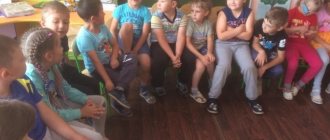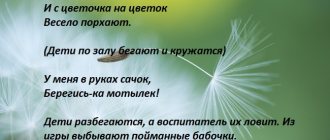Summary of a lesson in speech and alternative communication on the topic: “Maintaining a dialogue on a given topic.”
Abstract of speech and alternative communication.
Subject:
“Maintaining a dialogue on a given topic.”
During the classes:
Organizing time.
Communication game “Hello!”
(words and music by M. Kartushina)
.
Hello, palms! Extend your arms and turn your palms up.
Clap-clap-clap! 3 claps
.
Hello legs! Spring.
Top-top-top!
They stomp their feet.
Hello cheeks! Stroke cheeks with palms
.
Plop-plop-plop! Lightly pat the cheeks 3 times
.
Surprise moment.
Exercise "Cat".
(
The teacher brings 2 baskets
).
I brought you a basket. A big cat sits in it. The fur is very smooth,
The cat is very soft. Here are the eyes looking, here are the ears sticking out, here is the mouth with a mustache,
Here is a fluffy tail, here are four paws, and there are scratches on them. ( during the reading of the poem, the teacher asks the children: Seryozha, show me where the cat’s eyes are? Where are your eyes? Maxim, show me where the ears are? Are these ears?
- Let's show how a cat walks. She walks quietly, inaudibly. Follow me, everyone.
We'll show you a little, ( The children walk quietly on tiptoe
) the cat steps softly.
Barely audible: top-top-top, (onomatopoeic
)
Tail down: op-op-op.
- And the cat didn’t come alone. Look, kittens are sleeping in a small basket. Let's take a look, just quietly so as not to wake the kittens ( the teacher removes the scarf from the basket, the basket is empty
).- Where are the kittens?
Seryozha, where are the kittens? No kittens? ( to achieve a response gesture, onomatopoeia
). — The kittens ran away. Let's look for them.
Playing with sand
(buckwheat, rice) (
children “immerse” their palms in the sand).
- Who is this? Are these kittens? (achieve an affirmative sound, gesture).
What kittens?
Kittens are small. Show how small they are (children show with a gesture).
- Look, what kind of cat? Is the cat big? Show me which cat is big? ( children gesture
).
— What is the kittens’ mother’s name?
Finger game “Kitten is naughty.”
The kitten calls its mother: “Meow-meow, meow-meow.” Children rhythmically connect the same fingers of both hands.
He didn't drink the milk: - Little, little, little, little.
Cross your fingers, rhythmically lower and raise your fingers.
Mom feeds her milk: - Mur - pur - pur, pur - pur - pur. Rhythmically stroke the back of the other with the palm of one hand.
Curls up in a small ball: - Ur - ur - ur, ur - ur - ur. Rhythmically rub fist against fist.
He will play with the ball. Tsap-tsap-tsap, tsap-tsap-tsap. Rhythmically clench and unclench your fingers.
And the thread will quickly unwind. Up-up-up, up-up-up. Make rhythmic circular movements of the index fingers around each other.
Game "Colorful Balls".
— Kittens love to play with balls. They played and scattered all the balls. Let's help collect them: yellow balls into a yellow box, green balls into a green box.
- Well done, you put all the balls into boxes correctly.
- Oh, who's that squeaking? ( audio recording of the mouse's voice sounds
). - That's right, it's a mouse (showing a toy - a mouse).
Game: “Catch up with the mouse.”
The kittens saw the mouse and ran after the mouse.
Children put kittens (finger toys made of felt) on their fingers and “walk” in the “footsteps” of the little mice.
Kittens walk, sing a song: - How do kittens sing a song?
( children imitate the voices of kittens
). Meow - meow, I'll catch the mouse.
Game "Fishing".
The kittens did not catch any mice and went to the river to catch fish (
children “catch” fish
).
We caught a lot. Let's put the big fish in a large bucket, and the small ones in a small one ( put the fish in buckets by size
).
Game "Treat".
The kittens are hungry - let's feed them
(silhouette image of kittens on a wooden clothespin on both sides; press - feed (fish
).
Communication game “Farewell”
(words and music by M. Kartushina).
Goodbye, goodbye, goodbye, friends! We'll wave goodbye to everyone, you and me. ( Children wave their hands
).
Reflection.
- Who came to visit us today?
( children show
).
- Sergey, show me where the cat is? Maxim, show me where the kittens are? What cat? What kittens? ( show with a gesture
).
That's right, a cat with kittens came to us. The cat is big and the kittens are small. We helped the kittens collect balls. Sergey, show me where the yellow balls are? Maxim, show me where the green ones are? We fed the kittens fish. We made beautiful fluffy rugs for the kittens. ( The teacher invites the children to play with the cat and kittens on their own
.)
Communicative games in music classes in kindergarten
Communicative games in music classes in kindergarten
Kindergarten is a space in which children learn to build relationships with each other and with society. The lack of proper communication skills slows down the adaptation process. Therefore, at the first stage, the teacher’s efforts are aimed at uniting the children’s team and creating an atmosphere of goodwill in it. This is facilitated by communicative games and joint activities. The ability to interact with other children is a step in the psychological maturation of an individual. In a preschool institution, a child must develop communicative competence for a more successful transition to the next educational level.
Developing communication skills in kindergarten is an ongoing process. It continues in music classes, where children learn to convey emotions using speech and non-speech (facial expressions, gestures, posture, pantomime, dance, instrumental improvisation) means.
There are several problematic forms of self-expression that interfere with the flow of the educational process:
- aggressive behavior: loudness, pugnacity, rudeness - evidence of the child’s emotional tension,
- touchiness, expressed in painful experiences, if not chosen, ignored,
- shyness, which is expressed in uncertainty, timidity, anxiety, tension, fear of peers,
— demonstrativeness, which is a stable personality trait.
These negative forms are characterized by inattention to other children and an inability to understand the feelings of another person.
Communication games are aimed at developing a positive attitude towards each other, the ability to control one’s feelings, empathize with others, constructively interact and cooperate.
Communicative games presuppose the following conditions: - taking into account the individual characteristics of each child, - accepting any choice of the child, - the desire of the teacher to play with the children, - a friendly attitude towards students, - the teacher’s ability to follow the child’s needs, - the ability to improvise, depending on circumstances - to encourage children's initiative when children can refuse a planned activity and make another proposal.
When learning the game, the teacher sets a personal example (“do as I do”). In the future, he continues to take an active personal part in gaming activities, adjusting and directing the process as long as this is necessary. The teacher gives only positive assessment.
In communicative games, the moment of comparison and competition is excluded so as not to provoke in children such qualities as competitiveness or demonstrativeness. Children are not forced to play so as not to cause negative emotional reactions. It is important that the communicative game is varied. The text of the game does not require prior learning and is memorized through repeated repetition. The communicative game is aimed at developing positive personality traits: kindness, responsiveness, courage, goodwill, and sociability. Games can be used in any routine processes, in any classes, during a walk, leisure, play activity, in a group and individually.
A large number of games are played in a circle. The circle is a special unique space that includes all participants in the process and allows players to see each participant. In my opinion, this is the most successful form of play for a new team.
In my practice, I often use communicative games at the beginning of the lesson, when the children and I greet each other, and at the end. Below are some examples of favorite and frequently used games.
When music frames the game, it becomes musical and can harmoniously fit into the music education program. Musical accompaniment gives the game a rhythmic pattern and melodic expressiveness. Musical communication games become the highlight of any holiday, activity or leisure time.
As a rule, for children of primary preschool age this type of musical activity such as singing is difficult. Kids can make noise in a group, scream on the street, and have loud, casual conversations in direct play activities. However, when performing songs purposefully, they often get lost, sing uncertainly and sluggishly. Musical communicative games contribute to the development of the children's vocal apparatus by involving the child in the direct play process. Games with a small song for the presenter are very useful for this. This promotes liberation and helps you learn more vivid and expressive performance. Even shy and introverted children are gradually included in the gameplay, called upon to play the role of leader and begin to receive positive emotions.
Several examples of musical communication games.
For the younger group (3-4 years)
"Hide and Seek with a Handkerchief"
Children and adults move around the hall to the accompaniment of music. An adult has a large handkerchief in his hands. When the music ends, children sit down and cover their eyes with their hands. An adult covers a child with a scarf, asks the children to open their eyes and guess who is missing? Who's hiding?
"Clear sun"
(game model by I. Kurkina) One child is the sun. He stands in front of other children and hides. You can use a scarf or a screen. The children sing: “Clear sun, come out! Clear sunshine, shine!” Child - the sun is coming out. The children hold out their hands to him, palms up, and sing: “Come out soon, sunshine. Caress and warm! To the music, the child - the sun - walks around, strokes everyone's palms one by one, and at the end of the music he chooses a new sun. The musical accompaniment is gentle and light.
"Loaf"
is a well-known and very effective communication game that can be played not only for birthdays.
"Checkbox"
Goal: To teach children to interact with each other, develop interest in peers, and auditory perception.
Words: Children stood in a circle, saw a flag, Who should I give it to, who should I give it to, Who should I give the flag to? Come out, Sasha into the circle, Sasha take the flag. Wave to all the guys and put them back.
Progress of the game: children stand in a circle, in the middle of the circle there is a flag. The teacher and the children walk in a circle and say the text. The child comes out according to the text, picks up the flag, then waves it and puts it back. Then the game continues.
"Merry Tambourine"
This game is easier for children in the middle group, or in the younger group in the second half of the school year. Children pass the tambourine in a circle to each other. Whoever has the tambourine at the end of the song stands up or goes out with the tambourine to the middle of the circle, plays the tambourine, and everyone supports and claps.
Words: You roll the cheerful tambourine Quickly, quickly through the hands of the one who stopped, He will now play for us.
The game teaches you to interact with each other, support the performing child and develop endurance.
Games for middle group children (4-5)
(from 4 to 5 years)
"Hello, dear friend"
This game has musical accompaniment. (Lyrics and music by I. Kurkina)
Purpose of the game: after moving in all directions, be able to quickly find a couple, greet your partner kindly, using expressive singing and dance movements. Contents: An adult says: “Once the legs set off to travel along the path...” To the music, the children move around the hall.
“Our legs walked along a straight path. We walked, we walked, we walked to the music. Our legs walked along a straight path. We walked and walked and met a friend.”
At the end of the words, the children look for a mate. Stand in pairs, perform simple musical and rhythmic movements and sing along:
“Hello, hello, dear friend! Don't look around! You better smile at me and make friends with me!”
At the end, the children hug each other and the game repeats. “The legs are off along the path again!”
With each repetition, the music director changes the nature of the musical accompaniment and the children move in accordance with it: marching, running, jumping, sneaking steps, etc.
Game "Guess whose voice"
Rules:
The child stands in the center of the circle. Children walk in a circle and sing: (Name) we are in the forest now, We are calling you, AU. (Name) close your eyes, find out who called you.
The adult points to any child from the circle and he sings (calls) the name of the one who is standing in the circle. The child in the circle guesses who called him and changes places with him. Game continues. The game can be complicated by singing not the name, but simply “Ay.”
“This is how we meet friends” (accelerated)
The game can be played to the Belarusian folk melody “On a Green Meadow” (lyrics by I. Kurkina) Purpose of the game: to greet your partner kindly, using expressive gestures and singing. In addition to communicative tasks, in the game children learn to perform dance spatial rearrangements: counter movement in the spirit of a column and a “comb”, continue to reinforce the concepts of “right-left”.
Progress of the game: children stand in two lines, at a distance of 4-5 steps from the cent, opposite each other and everyone knows their partner, i.e. the one standing opposite. Children sing the game song and at the same time perform the appropriate movements:
We'll wave our hand - like this!
(we wave to our partner with our right hand)
We will wave with the other - like this!
(we wave to our partner with our left hand)
Let’s approach each other - like this!
(four steps towards your partner - both ranks converge along the center line)
And let’s hug each other - like that!
(we hug our partner)
Let’s smile at each other - like this!
(we smile and look at our partner’s smile)
Let’s give a hand to a friend - like this!
(to the word “here” everyone puts their right hand palm up, to the word “so” they put their left hand on the partner’s right palm)
And let’s jump up together - like this!
(they jump up at the same time - 1 time for the word “so”)
Together we have more fun - like this!
(to the words “together we have more fun,” we swing our clasped hands twice, crossing them and spreading them apart; to the word “here,” clap with a partner with the palm of the right hand; to the word “so,” with the right hand, everyone performs the gesture “Wow!”)
Next, the children pass with their left shoulder past their partner to the opposite side (exchange lines-ranks as in the dance pattern “comb”, “comb”). After completing 4 steps, they turn around again to face their partner. The game is repeated, but at a faster pace (musical accompaniment and singing speed up each time).
Not every middle group can master the game in ranks, so I play it in a circle, not particularly focusing the children’s attention on the right and left hands. In this version, it is also possible in the younger group. In this case, the words are replaced with: “Let’s come to the middle - like this!” And we’ll go back our separate ways - just like that!”
Or:
“We will turn our backs - like this!
And we’ll turn our faces - like this!” Before repeating the game, you can play a musical passage so that the round dance has time to spin. In ranks, the game works better for children of older preschool age.
"Handkerchiefs." Target
: development of expressiveness of movements, sense of rhythm and tempo, visual-motor coordination.
Progress of the game: children stand scattered, each holding a handkerchief. They move around the hall to light music and sing:
I'm walking, walking, walking. I'm looking for a friend.
Stop in front of the chosen child and sing:
Hello, hello dear,
I'm glad to meet you.
Everyone takes the tip of their friend’s handkerchief and imitates “sawing wood.” At the same time the following words are sung:
Hello my joy, let's dance into sweetness, We dance well, we'll say goodbye easily
(waving a handkerchief and going to look for a new pair).
"Guess whose voice it is."
Target:
development of auditory and visual attention, tactile memory.
How to play: Children form a circle and join hands. In the middle is a blindfolded child. Children walk in a circle and sing:
So we built a circle, Let's turn around at once.
They turn and go the other way.
How about we say: “Skok-skok-skok”
(these words are said by one of the children),
Guess whose voice?
Turn around quickly and touch me with your little hand. Hurry up, guess, answer quickly. “Zhmurka” tries to guess from the voice who called him. If he doesn’t guess, he tries to find out by touch.
Cap.
Goals: the child shows initiative and independence in various activities, for example. in the dance room.
Cultivating friendly relations with each other. Content: children stand in a circle. In the center there is one child - the “cap” - squatting. Children walk in a circle saying:
“Cap, cap Thin legs Red boots We gave you something to drink, We fed you, We put you on your feet, We made you dance.”
Children stop, clap their hands and say:
“Dance as much as you want. Choose whoever you want"
The “cap” child dances and chooses another “cap”.
For children of senior preschool age
(5 – 7 years old)
.
"Friends"
A rather complex musical game with changing partners and a fast pace, but if children master it, they play willingly and with great pleasure. In the game, children become familiar with the concept of outer and inner circle.
They ran, they ran quickly in pairs, they ran in pairs, holding hands, and they threatened each other: “Don’t you dare quarrel!” shaking a finger Clap your hands, clap each other's hands. They hugged tightly, the couple was changed, the outer circle changed partners, and they held hands.
“A goat walked through the forest”
A game with the gradual inclusion of all children. Progress of the game
: Players form a circle. In the center is the driver...
A goat walked through the forest, through the forest, through the forest, (the driver performs the movements according to the text) He found himself a princess, princess, princess, (they choose a mate from the circle) Come on, goat, let's jump, jump, jump, And we'll jump with our legs, we'll jump, we jump, we jump. And let's clap our hands... And stomp our feet.... Let's hang out with you and be friends forever!
(The couple separates and each participant becomes a leader, choosing a new pair until all children have been selected).
You walk
Children walk to music, sing and perform movements according to the text.
You walk, you walk, don’t yawn your way. You go, you go, choose a mate for yourself. Say hello with your palm and your beautiful leg. With your shoulder and elbow and of course your tongue... GOOD MORNING! (either day or evening)
You walk, you walk, don’t yawn your way. You go, you go, choose a mate for yourself. Say hello with your head, as you do everything deftly, with your fingers, fist and, of course, tongue.....HELLO!
You walk, you walk, don’t yawn your way. You go, you go, choose a mate for yourself. Stroke your friend on the top of the head and whisper a secret in his ear, Say hello with your side and, of course, with your tongue.....HELLO!
"Merry Choir"
Children are divided into subgroups (kittens, puppies, etc.) Each subgroup sings 1 verse of a familiar song with the syllable “meow”, “woof”, etc. Then everyone sings in chorus, each in their own syllable.
Musical and communicative game “Peek-a-boo”. (
Author unknown) Children stand in pairs in a circle facing each other. Verse 1: I’ll run away from you, I’ll run away…. on an easy run, change places - 3 times; I’ll hide behind a tree with my hands in fists and cover my face with my palms; And I’ll say: “Ku-ku!” look right, then left
Losing: The inner circle claps, the outer circle side gallops in a circle and returns to the partner.
Verse 2: I’ll swim away from you, I’ll swim away…. step change places; swing your arms (3 times) I’ll hide behind the boat, sit down, cover myself with my hands as a “shelf” And say: “Peek-a-boo” stand up, spread your arms
Losing: The inner circle claps, the outer circle side gallops in a circle and returns to the partner.
Verse 3: I’ll fly away from you, I’ll fly away... While running lightly, they change places, swing their arms. I’ll hide behind a tree and cover myself with a “shelf” and say: “Peek-a-boo”, spread my arms
Lose: repeat
4 figure I will run away from you, I will run away (they change places imitating fast running) I will swim away from you, I will swim away (they change places imitating swimming) I will fly away from you I will fly away (they change places imitating the wings of an airplane) This is how I play, I am friends with you - shake the right ones hands I play like this, I love you - hug
Loss: They spin around with a couple of jumps and a “twist”, claps. The children take their places.
Argument
(Children stand in pairs, perform movements according to the text.)
Two cats are quarreling today; their claws are sharpening on the fence. The fur stands on end, they snort, hiss, and want to scratch. Calm down, don’t be angry and make peace with each other - Rather than walking around beaten, it’s better to live in a good world!
(Children change pairs)
Umbrella game
The children went out for a walk, the sun couldn’t be seen, the clouds were gathering, it was starting to rain. (Name) open your umbrella, save us from the rain!
(The child takes an umbrella and covers 2 children. These children run in the outer circle, whoever takes the umbrella first stands in the circle).
"Eresponze"
I spied this game from my colleague. Unfortunately, the authorship could not be established. Most likely, she is of foreign origin. I explain incomprehensible words to children as a cheerful song sung in an incomprehensible language by a magical elf from a magical land of flowers.
This is a game with the gradual inclusion of all children.
How to play: Children stand in a circle. One leader is selected. He walks in circles. Everyone sing the following words and clap to the beat:
Eresponze, eresponze, eresponze re-ze-ze (2 times)
Aaaaa - yo, aaaaa - yo, aaaaa - yoyoyoyo
On “aaaaaa” the child approaches someone from the circle, on “e” he claps his hands. Once again, in the same way, and the third time, with a “yeeeeeeeeeeeeeeeeeeeeee,” he hugs the one he chose. Now he and the chosen child walk in a circle and the game repeats.
The good thing about the game is that it helps develop a sense of rhythm and helps children sing well to the vowel “A.”




